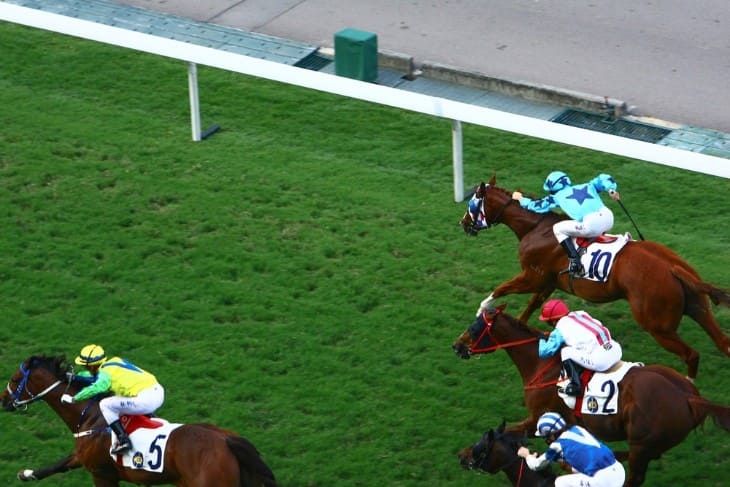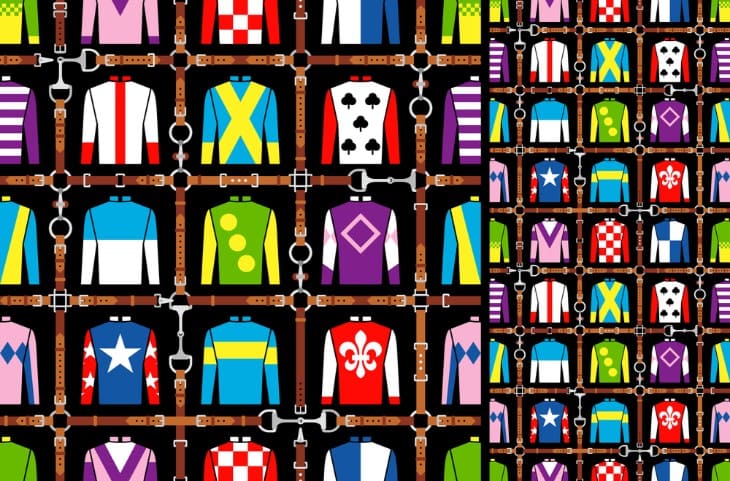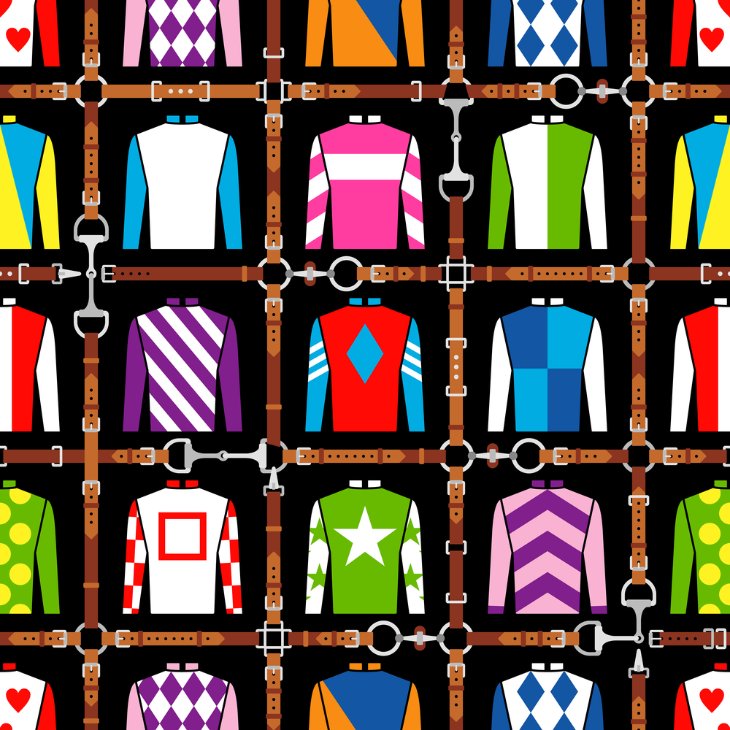Not only is horse racing a sport that embodies centuries of tradition and history, but it also boasts an astonishing visual culture. One of the most impressive aspects of this culture is the jockey's silks. These bright clothes go beyond just their function to symbolise heritage, identity and claim to ownership. This article explores the background, meaning and strict regulations behind these symbolic costumes to demonstrate how they have retained their status as horse racing's backbone.
The Historical Roots of Racing Silks
Racing silks have historical roots dating back to the 1700s. By then, horse racing had become a popular sport among British elites. That is when the idea of different silks was developed into practice. The intention was to make each rider stand out from his fellow riders while on fast-running horses so that people in attendance could easily identify him. These were the simple beginnings of what has evolved into a richly woven tradition that spans centuries.
Every owner designed unique silk attire for their jockeys. The attire was usually very bright and could be seen from far-off distances easily, making it easy for people watching races to identify the jockeys individually without much struggle. As horse racing became more widespread, these silks became symbols of pride and heritage, representing the colours worn by the owner and his family or even social status.
As time passed, it became entrenched as part of custom rather than just being done casually like before. The officials governing racing came up with stringent conditions which stated that every set of such clothing must be recorded under specific owners' names, hence allowing no two riders to look alike during any competition, thus keeping this old norm alive today. This rule also made official something initially meant to serve practical purposes, ensuring that silks remained an essential element of horse racing's fabric.
Nowadays, colourful race gear does not simply help an individual racer distinguish themself better among a group of jockeys. These bright silks also link the modern sport and its rich historical past, reminding us how horse racing transformed from an elite game into a popular show.
Symbols of Ownership and Identity
Silks are vital symbols of ownership and identity in horse racing, rather than just colourful clothes. Different sets of silks are created to represent each horse's owner, with personal preferences and family heritage usually taken into account. Each set has unique characteristics that make it memorable and easily recognisable on the track.
The selection of silk colours and patterns is not done arbitrarily by owners but with caution. This may be influenced by factors like family background, corporate brands, or even favourite colours. For example, some may choose red and gold, representing wealth, while others might go for blue and white, indicating peacefulness or conservatism. It is thus a very personal choice that can turn any jockey outfit into an expression about who possesses it.
Through this tradition, one can identify which horses belong to particular owners. Additionally, it brings an element of personal attachment to races, where people feel proud when their horses win for them at the tracks. A success achieved by an owner's steed during a contest becomes more than a single animal's glory but also represents their selected colours through which they reveal their character.
Designing and registering these silks with racing authorities is a rigorous process. Each design must be unique and adhere to strict guidelines to avoid duplicates on the track. This helps maintain the integrity of the sport and ensures that silks truly represent their owners.
Silks do more than clothe a jockey; they blend the sport's competitive spirit with personal stories and histories that shape this rich tapestry of connections defining horse racing. This combination of tradition and individual expression makes using silks a treasured practice in the sport.

Silk Making as an Art
- Material and Design: Silks are made from lightweight and strong materials. The fabrics used are typically silk or synthetic blends chosen for their ability to hold up under the stress of racing while still allowing jockeys ease in movement so they don't experience discomfort while performing.
- Customization and Uniqueness: Every set of silks is customised, ensuring its uniqueness. Therefore, designing entails choosing colours and patterns, which have to be approved by racing authorities before being registered with them. During this registration process, no two jockeys wear similar designs in one race, thus preserving this tradition of individuality within the sport.
- Craftsmanship and Technology: Silkmaking combines traditional sewing methods with modern technology. Attractiveness aside, precision in construction is important since it affects functionality during races, too. Technological advancements in textile production have enabled features such as improved breathability or moisture wicking, providing greater comfort for riders.
- Cultural Significance: The creation of silks goes beyond its practicality; it has cultural importance embedded within it. This shows a deep regard for tradition and heritage associated with horse racing events. These colours and patterns often have historical links connecting current jockeys and owners with past generations.
The making of silk involves the blending of art, science and a tinge of history. It is a process that combines individual attributes, culture and performance on which horse racing stands.
Role of Regulations in Silk Designing
Regulations play an essential role in the design of horse racing silks. By doing this, those rules exist to ensure that no two jockeys wear similar silk sets during a race. Before being used in any riding event, the designs must be approved and registered with the relevant authorities. This is aimed at preserving order and justice within the game.
Any owner who wants to register their silks must submit their draft for approval. To prevent replication, the authorities check these drafts against existing registrations. If two owners present similar designs, the one who sent the first will be granted permission. This rule is strictly adhered to so that each horse and jockey can be recognized easily during any race.
These regulations are essential since they maintain traditionalism while making current races run smoothly. In this respect, observing such directives would disorganise spectators and officials attempting to follow participants around tracks. Also, these regulations help keep up honesty in horse racing by ensuring justice in competition among all contenders involved, as laid down by these rules and regulations.
The orderly conduct of horse racing requires respecting the rules governing silk design. Otherwise,;, there would be a lot of confusion in the tracks and disputes over who doesn't own what. Also, it is important to note that they do not just provide a medium for the sport's practicalities but equally respect its long-standing tradition.
Silks and the Role They Play in Racing Culture
Silks occupy an essential place in racing culture and are more than just garments for jockeys; they are an integral part of the pageantry and history of horse racing. On race day, a kaleidoscope of colourful silks contributes to visual excitement and makes each event lively. Its visual appeal is critical to attracting attendees, thus making it one of the most fascinating sporting activities.
However, silks' role is not just about good looks but also about creating identity and a sense of pride among owners and jockeys. In this symbolic way, when riders take to the saddle with such coloured clothing, they carry all that betters might have invested in their horses' winning chances. To win a race dressed in their particular silks is seen as an honour that celebrates personal victory and underscores shared success among the team behind the scenes, including the owner.
Silks also ensure that ties with the sport's background are maintained throughout time. Many silk designs have been handed down through generations over a century, with some families still using similar colours even today. This helps link previous events to current happenings, which forms part of the living heritage witnessed during races.
Silks form part of how horse racing defines itself culturally. They add visual drama to the sport, embodying people's stories while connecting modern racing to its historical roots. Silken splendour grows out of this perfect blend, represented by beauty, loyalty, and expectation for future generations.

The Transformation Of Silks In Present Day Horse Racing
- Technological Innovations In Fabric: The materials used for making silks have seen significant technological improvements in recent years within contemporary horse racing. Modern designs use advanced synthetic materials that are lighter and breathable and wick away moisture better than previously available silk materials from traditional sources. These features enable jockeys to remain comfortable during races even when weather conditions are harsh.
- Design Innovations: Modern silks have also incorporated modern design technologies. Digital printing and graphic design offer endless possibilities for creating detailed and vibrant patterns. This allows for more complex, individualised designs that reveal owners' styles and personalities more vividly on the track.
- Regulatory Adjustments: With racing changing throughout the years, so have the regulations about riding silks. They have evolved to meet safety standards as well as commercial interests. For example, some jurisdictions now allow sponsor logos on sills, combining commercial opportunities with traditional race wear.
- Cultural Impact: The development of silks reflects more significant changes in horse racing culture where tradition and modernity meet. While essential characteristics relating to their meaning in terms of symbolising ownership through their course or ceremonial roles remain unchanged, how they are made or used has changed due to evolving tastes and trends.
This transformation of silks in horse racing shows how a sport can maintain its roots while embracing new ideas that improve its performance and charm. Despite this revolutionization, silks remain essential to horse racing's culture and identity.
Holding onto Tradition But Embracing Change
One of the most essential things in horse racing is balancing tradition and modernity. It is a sport that boasts a rich historical background, especially notable through the use of silk garb. However, while their basic purpose remains intact—to identify riders and reflect ownership—the way they look has changed according to contemporary technologies and societal shifts.
Traditionally, silk was made from fabric, but today, silks are made of very efficient synthetic materials. These fabrics make the silks stronger and more comfortable for jockeys. Moreover, design practices have transformed with the introduction of digital tools that offer more vivid colours and intricate patterns than ever before.
However, racing still cherishes the historical significance attached to silk. Its designs and uses are kept strictly intact to uphold its grand past. Such traditionalism ensures that modernisation retains the identity of jockey's attire.
This delicate balance between change and preserving history makes horse racing lively and meaningful. This means new followers will be attracted to it while maintaining its long historical roots. The interweaving of modernity into tradition demonstrates that horse racing has evolved considerably through time without losing its true spirit.
Final Verdict
These tips help you choose your ideal riding gear, jackets, shoes or gloves. Horse-racing silks represent not just colour – they embody this sport's heritage, identity and unwavering soul. Each piece carries tales of bloodlines, ambition, and love for this timeless game, those things which will never go out of fashion. Therefore, this ancient tradition known as horse racing could not be complete without these attire, keeping them relevant while evoking emotions from all corners globally.








